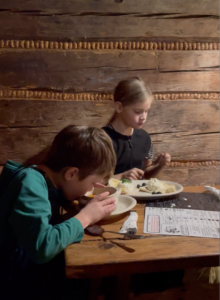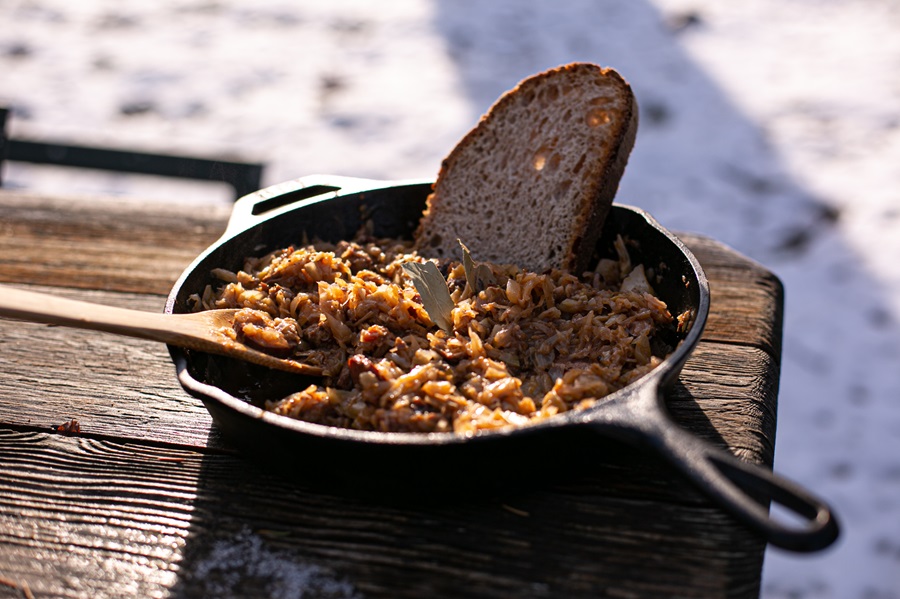I grew up in 1980s Poland, where my mother and father took an old-school approach to parenting — meaning tough love and a lot of faith in our abilities.
This showed in my father’s way of leading our winter skiing expeditions. There were no ski lessons or long explanations, and there was no hand-holding. He would take us to the top of the run and simply say, “Go — see you at the bottom!” and so, we would go — my brother and me in survival mode, somehow figuring out how to ski.
Some of my earliest memories are from trips to Zakopane in the Tatra Mountains. Getting to the mountain hut meant hiking for hours with our backpacks and skis. After a long trek to reach the ski lift that would take us to the top, exhausted, wet, tired, and somehow happy, we’d finally reach one of the wooden mountain-style restaurants built right on the slopes and order bigos, a hunter’s stew. It tasted like a hot bowl of heaven, the purest comfort possible.
We’d gather around the fireplace in the middle of the karczma (a traditional mountain tavern), or, if there was no room inside, we’d sit outside. No matter: the steaming, hearty stew would go down my throat and warm me from the inside out. It gave me the strength to get through the rest of the day, including the long walk to our schronisko (shelter).

Bigos translates literally as “a lot of things mixed together.” I believe the dish’s name and its tradition of being eaten after a hunt are tied to its mention in Pan Tadeusz (The Last Foray in Lithuania: A Nobility’s Tale of the Years 1811–1812, in Twelve Books of Verse). The epic poem by poet-philosopher Adam Mickiewicz was first published in Paris in 1834 and is considered one of Poland’s most important works of literature. In one passage, the stew is described in such a way that you can almost smell it:
… bigos is no ordinary dish, for it is artistically composed of good vegetables. The foundation of it is sliced, sour cabbage, which, as the saying is, goes into the mouth of itself; this, enclosed in a kettle, covers with its moist bosom the best parts of selected meat, and is parboiled, until the fire extracts from it all the living juices, and until the fluid boils over the edge of the pot, and the very air around is fragrant with the aroma.
The bigos was soon ready. The huntsmen, with a thrice-repeated vivat, armed with spoons, ran up and assailed the kettle; the copper rang, the vapor burst forth, the bigos evaporated like camphor, it vanished and flew away; only in the jaws of the caldrons did the steam still seethe, as in the craters of extinct volcanoes….
My grandmother always prepared an enormous pot of bigos on Christmas Day. She’d tell me that the secret to a great bigos was that it needed at least three kinds of meat and must simmer for at least two days — the longer it cooked, the better it tasted, she said. I like to make it the day before I plan to serve it. Bigos tastes even better that way, as the flavors continue to meld. It can be stored in the fridge for up to a week.
Making bigos here on the Outer Cape has its challenges. The sausage, which is a key part of the dish, is especially hard to come by. For the pot I made this week, I ended up buying kiełbasa at a local supermarket, but it’s not the same as the real Polish sausages you can get at the Baltic Deli in Dorchester’s Polish Triangle.
We Poles take pride in our wide variety of sausages, and everyone has a favorite. My choice would be kiełbasa wiejska, a lightly smoked pork sausage seasoned with marjoram and garlic. Another challenge is finding dried mushrooms, which are essential for bigos. I get dried cepes (also known here by their Italian name, porcini) at the Food Port International Market in Hyannis, which carries lots of Eastern European products. That’s also where I get imported Polish sauerkraut in a jar.

But a big pot of bigos is the reward for those willing to hunt for these ingredients. When I served it to a group of my Cape Cod friends (plus one from Germany) with thick slabs of good buttered sourdough bread alongside, they agreed it was the perfect comforting, homey food for these cold days. Though we were far from a mountain karczma, I found it had pretty much the same effect that it always did on me.
AGATA’S BIGOS
Makes 6 servings
1½ oz. dried mushrooms
½ lb. bacon, chopped
1 lb. pork ribs (about 6 ribs)
Optional: additional ½ lb. beef such as chuck or any leftover meats (the more variety, the better!)
3 Tbsp. vegetable oil
1 quart beef stock
1 fresh white cabbage, finely chopped (discard the tough center stem)
1 pint jar sauerkraut (squeezed to remove excess water)
12 large pitted prunes, chopped
2 onions, diced
½ lb. good sausage, sliced or cubed
1 Tbsp. tomato paste
4 bay leaves
A pinch of hot paprika or chili flakes
12 whole peppercorns
- Break the dried mushrooms into smaller pieces, pour hot water over them just to cover, and soak while you start the rest of the stew.
- Heat about half of the oil in a large, heavy-bottomed pot, add the chopped bacon, and cook for about 5 minutes, until crisp, then add the ribs and beef (bones and all) to the pot and pour the beef stock over the meats. Bring the stock to a boil, then reduce the heat to a simmer and let the meats cook gently for 45 minutes, covered. When tender, cut the meat from the bones, chop it, and return it to the pot.
- Chop the cabbage fine, discarding the tough core. Stir it into the pot with the meats. Cover and cook for another 30 minutes.
- Drain the soaked mushrooms, reserving the soaking liquid but discarding any grit accumulated at the bottom of the bowl. Add both the mushrooms and their soaking liquid to the pot. Squeeze the sauerkraut to remove excess liquid, then add it to the pot along with the chopped prunes and spices (bay leaves, paprika, and peppercorns). Stir well and simmer for another 30 minutes.
- In a separate pan, heat the remaining oil and sauté the diced onions until golden brown. Add them to the pot with the meat and cabbage mixture. In the same skillet, fry the sausage slices or cubes until browned. Transfer them to the pot.
- Final touches: Stir in the tomato paste. Cover the pot and let the bigos simmer for another hour, stirring occasionally to prevent sticking, and seasoning with salt and pepper to taste. Serve with crusty sourdough bread and butter.



